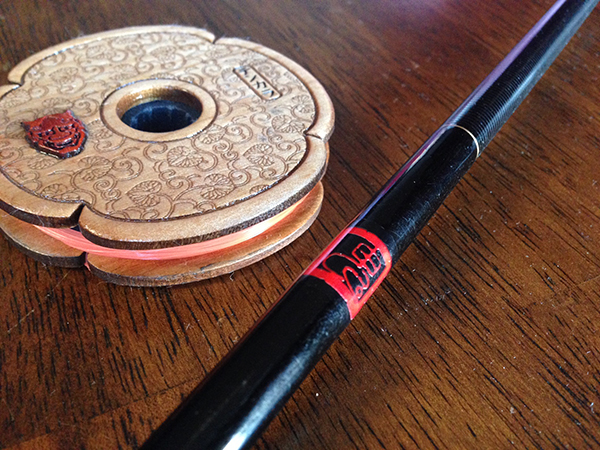
Quick post today. I’m often asked about my go-to setup for tenkara so I thought I’d just list it out. After years of testing and refining, I think I have finally come up with the combination that’s perfect for me.
Rod
For about the last year and a half, I’ve fished almost exclusively with an Oni Type I rod. Mine is the old school one (back when Masami Sakakibara assembled them himself) with no markings other than the Tenkara no Oni seal and a straight handle. It’s not as nicely finished as the new Oni rods, but it’s kind of become an extension of myself and fits my casting style perfectly, so I’ve found no reason to upgrade to the newer model. It’s weightless in the hand and casts a long, light line with pinpoint accuracy.
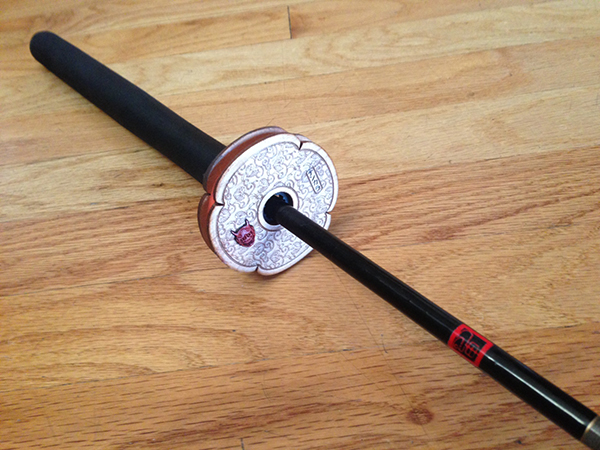
Line
I used to fish a Sunline #4 fluorocarbon line as my standard, but found that the Oni rod is capable of casting a much lighter line (even in the wind) which allows me to make very delicate presentations and makes it easier to keep my line off the water in a dead drift. So now, I fish with a #2.5 fluorocarbon line from Tenkara USA. Most of this year, I fished with an 18 ft. length since my local streams don’t have overhanging brush and I like the extra reach of the longer line. But I will shorten it up to 13 feet if I need to. I alternate between pink and orange depending on lighting conditions.
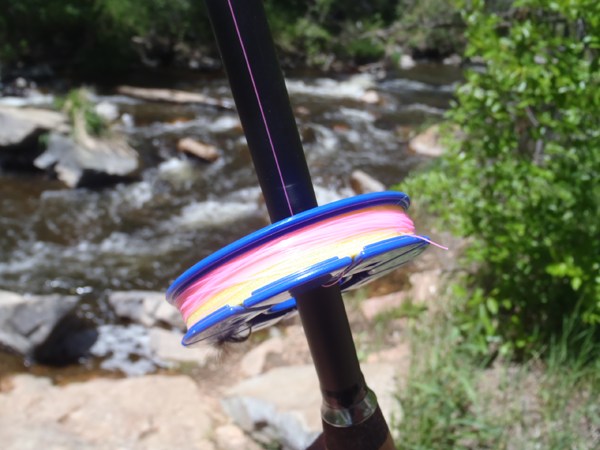
Tippet
For trout fishing with tenkara in Colorado, I’ve found no need to carry any tippet size other than 5X. The browns, rainbows, cutthroats and brookies I catch are relatively small and I can’t remember ever breaking a fish off due to tippet size. Plus, I typically fish a size #12 fly which is large enough to distract the fish’s attention from the tippet so I don’t think there’s a need to go thinner. I usually use Rio Powerflex.
Spool
For years, I used the Meiho blue plastic spools and they’re definitely one of the most ergonomic and practical spools on the market. Plus, they’re a reasonable price so it’s pretty cost effective to buy several. However, recently, I decided to go with something a little fancier (even if less practical). I’ve been using the wooden Oni tenkara spool hand made by Boulder artisan Dave Burchett on my last few outings and even though it may not be as practical as the Meiho plastic spools, the aesthetics of it compensate for the spartan looks of the Oni rod. I’m an aesthetically-minded person so these little details matter to me and affect my overall on-stream experience. And on some level, fishing is also an aesthetic sport after all, isn’t it?
Other Stuff
Of course, I bring other gear like a fly box, waders, hemostats, nippers, etc. but I’m not going to get into that here. I just wanted to outline my rod, line, fly, and spool. My terminal tackle and other gear can change from season to season, but I can’t see switching my main four any time soon. It’s taken a while to dial it in, but this setup feels so natural to me that using any other gear would feel like cheating.


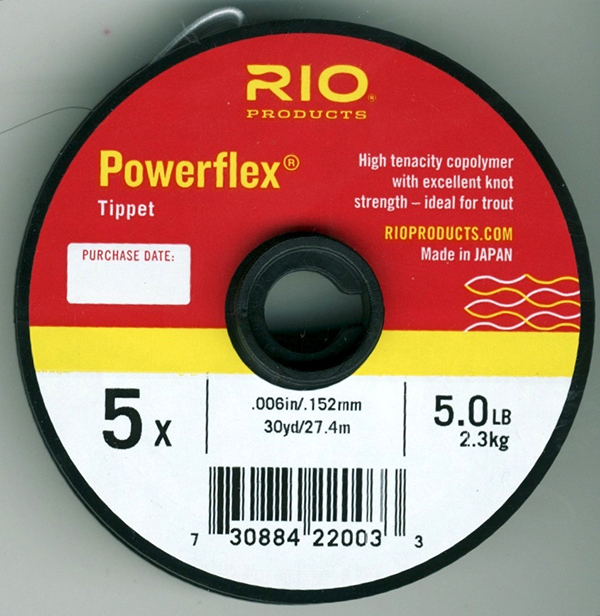
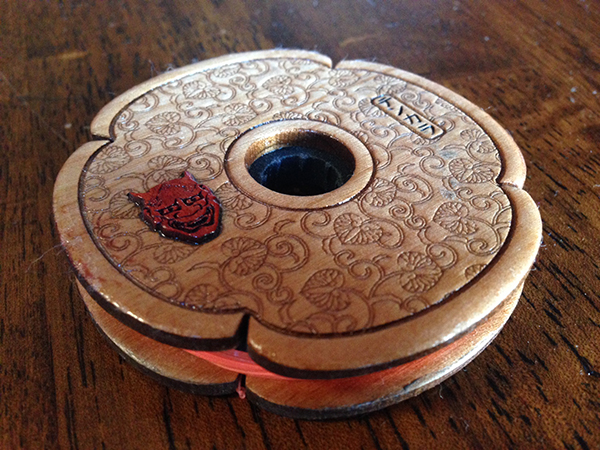






My primary rod is a custom bamboo gripped 1st Generation Type 1 Oni Rod.
3.0 Sunline level line. 5X & 6X fluorocarbon tippet.
A custom cherry wood hand carved dual line spool that was a gift from Dr. Ishigaki.
A small C&F ultralight fly box with a wide assortment of kebari patten flies.
I live in Texas and we few opportunities for trout, therefore, it depends on what species I’m fishing for as to what I consider ideal. If I’m fishing primarily for largemouth bass, the my Amago wiht the level section of traditional fly line is ideal. It can handle some larger flies that wouldn’t be much fun on a lighter rod. For trout, my Irana is my go to rod, with 3.5 level line of a tapered Tenkara USA line that I recently added a tippet ring to for quick changing of tippet. There will be more added to my quiver soon – Christmas is coming!
Jason. I’ve been reading your blog for sometime now and it has been interesting to read not only your gear reviews but also to read how your Tenkara journey has evolved.
I am new to Tenkara and have only one rod. A 1st Step 360 from Tenkara Times that I purchased from Three Rivers Tenkara. I like to rod a lot. As for line I am currently using a Sunline 3.5 fluro and a Katana furled line from Moonlit Fly Fishing. For tippet I also use Rio Powerflex 5x.
There have been times when I thought the 3.5 line might be a bit light. Especially if there is any wind. But I am not in the postion to go out and buy different lines to test. And a 3.5 was recommended.
Whether or not this is a “perfect” setup for me remains to be seen. A lot will depend on how far down the Tenkara path I go.
Despite having a half dozen rods to choose from, I primarily use an old Ayu with 3.0 level line and either Maxima or Rio 6x or 7x tippet. The light tippets afford me excellent presentation as well as a bit of insurance that it will easily break before harming the rod in the event I hook a larger than usual fish.
My favorite rod for most local applications is the Nissin Honryu 380. It’s rigged with a short (10′) 2.5 level line and about 5′ of 5X SA tippet. This rod seems to cast effortlessly, smooth and light. I wind the line and fly on home made leather ez keepers and slip the rod into a 1″ PVC rod tube when I’m done fishing. It only takes a minute to reverse the procedure and be back on the water.
Jason, when I fish wider rivers , which is the majority of the time, my tenkara rig is pretty similar to yours. 5 m of 2.5, 3.0 FC level line mostly. With 1 -> 1.5 m of 5x. Tippett brand whatever spool I happen to grab that day. Lately I’ve liked the Tiemco Fluoro Stealth Tippett from Tenkaraya. 90mm blue line spools or the yellow/brown Oni spools or a couple of hand carved oak spools made by a friend in Tn. But I’m not a one-rod guy. I alternate between the Oni type 1, T Times Try 390, NASH 450. Or occasionally the Daiwa 3.6 LL. And as the season turned cold the new TTimes Watershed 4m rod. All of them good rods with their own personality that are fun to fish with.
( btw, I noticed a week or so back that Oni is working on a 4.5m rod for next year)
Less often I fish smaller tighter streams with shorter lines and rods. Using a Soyokaze 2.7, or Nissin ZS 3.2 . At the end of summer I purchased Rhodo for the tight streams but didn’t get to try it yet. Those streams are full of the native Brook trout, not large and difficult to get to and to catch, but very pretty fish. They’ll have to wait till next spring to meet Mr Rhodo. Late in the summer the water was to low or the day was threatening rain storms and I didn’t want to be 2 hours up the creek without a ray of sunshine , and no quick way back to shelter. And unfortunately I didn’t get to fish at all for four weeks due to some family issues. But maybe I will get some fishing weather before spring and be able to fish the Rhodo on small streams close to home. Most of my fishing is done four hours away on streams near the family vacation house. Where it is 2,000 feet higher in altitude and has more streams nearby.
I hope this isn’t a stupid question, but talking about tenkara rigs, I have a question.
Can you pls tell me what 5m of 2.5,3.0 FC level line is. Also, with 1- 1.5m of 5x tippet.
I’m new to tenkara and am trying to get the proper set up for my rod. All I ever did was
put on a tapered leader w/a tippet ring and put a ft/ft1/2 of 5 or 6x tippet. If there
is a better set up, I’d sure like to try it, thanks……Jim Ritter
Jim, I’m sorry if my hastily written and abbreviated text was confusing to you. The failure to communicate is mine.
Some people fish with tapered lines (leaders), as you do. Which are lines where the weight of the line or diameter of the line changes over it’s length. Thus, it is a tapered line.
Most people probably fish with Level Lines (aka leaders), where the line is the same weight or same diameter over the length of the line. It is level, that is no change in diameter over its length. Level lines can be nylon or fluorocarbon (FC). I think most people use fluorocarbon level lines because FC is denser (heavier/diameter, that is it has a higher specific gravity) than nylon lines, which in general makes it easier to cast, especially in wind, than nylon lines.
Level lines are sold in different weights or diameters.The Japanese measure and classify their lines differently than we do here in the USA. Here most line is sold according to pound test. The Japanese list their line according to the ratio of the diameter, which will also be the ratio of the weight of the line.
What they call the Issue No. ( in Japanese 号番) No. 1 line is the reference size. So in their line rating system a No. 2 line will be twice the weight or twice the diameter of a No.1 line. A No 4 line will be twice the weight or diameter of a No 2 line and so on. Below is an image of a line chart from the Oni website, the line issue numbers (号番) are in the left column. Level lines are sold or listed according to the different line index numbers. Tenkara level lines sold here in sizes: No 2.5, No 3.0, No. 3.5, No. 4.0, No. 4.5, No. 5. Probably the most popular sizes are No.3.0 or No. 4.0.
http://www.oni-tenkara.com/jan/wp-content/uploads/2012/09/ponds.jpg
By 5m I meant a 5 meter length of line. About 16.4 feet. Of No. 2.5 fluorocarbon level line or a 5 meter length of No. 3 level line.
And by 1- 1.5m of 5x tippet. I meant 1 meter (about 39.5 inches) of 5x tippet or 1.5 meters of 5x tippet. I generally start with tippet of either length and use it until it gets to short after numerous fly changes. Each time I change flies I loses a few inches of tippet length with each change. 2.5 feet is getting to short for my taste.
If you look at the line chart you can see that 5x tippet is the same as No 0.8 line. Therefore, it would have aweight 20% less than No. 1 line or be 20% smaller in diameter than No. 1 line. Cool system,right?
Sorry that my abbreviated way of taking notes was confusing when posted publicly. That’s the way I take notes and I forget it may not make sense to others. And I am fairly comfortable thinking in metric lengths, which many people are not. I hope it now makes sense to you. Try some new rig setups , and catch some fish with them. D
Opps, Jim. I noticed just after posting that I made a mistake in one aspect of how I described the Japanese line No. System.
The line index numbers increase according to the ratio of the weight of the lines Or the ratio of the cross section area of the lines.
Before I wrote the ratio of the diameter of the lines. That is incorrect. I meant to write the ratio of cross sectional area (= same as the circular area) of the line. The old Pi radius squared formula.
The 3d column of the line chart list the diameters of the lines. But the ratio of the line diameters does not increase at the same rate as the line index numbers.
However, the ratios of circular areas of the lines does match the increase in index numbers of the lines.
The diameter of No 4 line is 0.330 mm. The diameter of No 1 line is 0.165mm. 0.330/0.165 = 2. Not 4.
But if you calculate the cross sectional area (the circular area) of lines with diameters of 0.330 mm and 0.165 mm.
You get .0855 /.02138 = 3.9986, which rounds up to 4.0. A No. 4 line will have 4x the circular area of a No. 1 line.
And will also be 4x the weight of the No. 1 line.
You will find the ratios of the circular areas of the other lines will also increase with the line numbers.
For example No 5 line will be 2x the circular area of No. 2.5 line. Or 5x the circular area of No. 1 line.
The practical application of that knowledge is that you will now understand the Tenkara level line numbering system and what the numbers mean what changing to a line of a different No. will do for you.
For example: If you are having trouble casting a No. 3 line in the wind you will now understand that if you change to a No. 4.5 line the line weight will increase by 1.5x. Or 150%.
But a change to No 3.5 will only be an increase in line weight of 1.16x or 116%. Not much of a change and not really worth doing. Hey, knowledge is good for making and educated change.
But otoh, just learning how lines of different weights cast differently by experience of just casting them is OK too.
I enjoy wading, don’t fish still or slow, deep water, and routinely have to deal with wind. RODS – Nissin Honryu 380 for most rivers most of the tie, Daiwa Kiyose 43M (longer, stiffer) for these rivers during high flows, and Nissin Pro Square 360 6:4 (shorter, softer) for creeks. LINE – During five years of fixed line fishing in mostly high to medium gradient flows and usually in wind, I found myself going ever shorter, with many reversals to longer lengths for reality checks. Now for both dry and wet flies it’s usually 5′ of #3 green fluorocarbon, #3 and green being smallest and best color for me to see locally. For extra low, clear water, if wind isn’t too bad, I’ll add a couple feet. TIPPET – 3’or 4′, usually cheap Stren Fluorocast (poor knot strength dry but OK wet) on 100m spool from Walmart, but otherwise Rio Fluoroflex.
John L
Canon City, CO
Hi, and there is not much to find online about Dave Burchett.
and there is not much to find online about Dave Burchett.
i would love to get one of those wooden spools but the link is really broken
Thanks!
Hi Martin, who, thanks for the heads up about the link. I removed it. You can reach Dave through his Etsy store here: https://www.etsy.com/shop/DaveBDesign